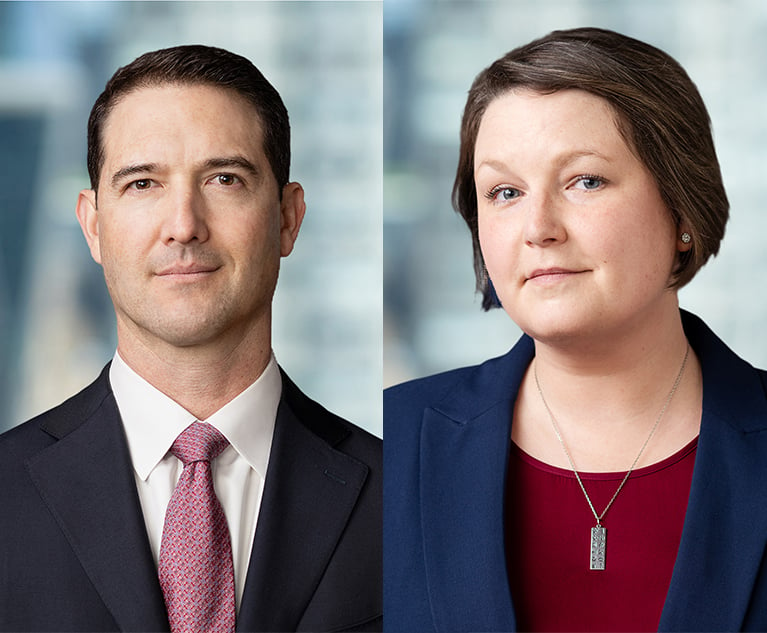Audit Trail 'Meta Data' Leaves Tell-Tale Signs in Medical Malpractice Actions
State E-Discovery columnist Mark A. Berman discusses audit trails of electronic medical health records, which can be the “silver bullet” for a plaintiff or a defendant depending on the facts of the case.
May 06, 2019 at 12:30 PM
6 minute read
 Mark A. Berman
Mark A. Berman
An audit trail of an electronic medical health record “shows the sequence of events related to the use of a patient's electronic medical records; i.e., who accessed the records, when and where the records were accessed, and changes made to the records” (Vargas v. Lee, 2019 N.Y. App. Div. LEXIS 2071, 2019 NY Slip Op 02142 (2d Dep't March 20, 2019)) and hospitals are required to maintain them under federal and state law (see 45 CFR 164.312[b], 10 NYCRR 405.10[c][4][v]). Audit trails can thus be the “silver bullet” for a plaintiff or a defendant depending on the facts of the case.
Just as the 2018 decision by the New York State Court of Appeals in Forman v. Henkin, 30 N.Y.3d 656 (2018), made clear that the rationale for allowing “liberal discovery” of social media “encourages fair and effective resolution of disputes on the merits, minimizing the possibility for ambush and unfair surprise,” recently the Second Department in Vargas held that such policy equally applies to the production of an audit trail of a patient's electronic medical health record. Courts are requiring the production of audit trails when they are relevant to a discrete time period, the “timing” of medical treatment and/or gaps or inconsistencies revealed by medical records. Critically, in Vargas, recognizing the evidentiary necessity to properly authenticate medical records at trial, the Second Department also noted that disclosure of an audit trail may be needed to assist in the preparation for trial by enabling “counsel to ascertain whether the patient records that were eventually provided to them were complete and unaltered.” Counsel for both plaintiffs and defendants need to heed the guidance provided in Vargas.
In Vargas, plaintiffs contended that since the allegations of medical malpractice included “the failure to timely and properly diagnose and treat plaintiff's medical complications following surgery, the requested portion of the audit trail was relevant to the timing and substance of plaintiff's care following surgery.” After specifically noting that “plaintiffs' request was limited to the period immediately following the injured plaintiff's surgery,” the Second Department held that “the requested audit trail was relevant to the allegations of negligence that underlie this medical malpractice action in that the audit trail would provide, or was reasonably likely to lead to, information bearing directly on the post-operative care that was provided to the injured plaintiff.”
In Miller v. Sauberman, 2018 N.Y. Misc. LEXIS 5954, 2018 NY Slip Op 33142(U) (Sup. Ct. N.Y. Co. Dec. 4, 2018), defendants would not produce the audit trail and “meta data” concerning plaintiff's patient health records, “identifying each user entering, making, editing, viewing, printing and otherwise acting upon plaintiff's medical record.” Plaintiff contended that “meta data” was “important and relevant to ascertain the identity, source and timing of the changes that were made to plaintiff's medical record,” as there were multiple versions of the medical records that contained conflicting entries for the same items on the same record for the same days.
The motion court ruled that plaintiff “made a sufficient showing for the production of metadata as defendant has yet to provide a credible explanation for the different and conflicting versions of plaintiff's medical record.” The motion court further noted that, while the audit report was intended to show “all edits, changes, or modifications to any single record” from May 8, 2014 through April 10, 2018, “the report produced no changes or modifications.” Thus, “[u]nder these circumstances, where there is no explanation for the different and conflicting versions of plaintiff's medical record, and where the issue as to when plaintiff developed bed sores is clearly material to plaintiff's malpractice claim,” the motion court ruled that concerning a limited period, “plaintiff is entitled to the metadata for his medical record to determine if the medical record was altered, and if so, when and by whom.”
In Dennehy v. Harlem Hosp. Cent., 2018 N.Y. Misc. LEXIS 4370, 2018 NY Slip Op 32496(U) (Sup. Ct. N.Y. Co. Oct. 2, 2018), plaintiffs contended that because their allegations were premised on “defendants' failure to properly and timely diagnose and treat Mrs. Lam, and because the hospital records exchanged by defendants are missing entries and show significant gaps in time, the audit log would reveal the timing of Mrs. Lam's treatment, which providers made the entries, and when the records were accessed and by which providers.” In opposition, defendants asserted that “neither Dr. Clark's testimony nor the records suggest that Dr. Clark revised the notations of other medical personnel, that Dr. Clark's notes were improperly or erroneously altered, or that Dr. Clark's treatment of Mrs. Lam as set forth in the medical charts would be compromised or contradicted by any audit information or metadata.”
The motion court thus found that plaintiffs “have not laid a proper foundation in support of the belief that there are entries and notations missing from Mrs. Lam's medical records and Dr. Clark's notes, or that there is information contained within the metadata of Mrs. Lam's records that would account for any 'significant gap' in time in Mrs. Lam's treatment at Harlem Hospital on August 1, 2016.” The motion court noted that “[p]laintiffs have also failed to allege or demonstrate that Dr. Clark or any other medical personnel revised, deleted, or doctored Mrs. Lam's medical data, or that any notations or entries, or lack thereof, differs from or contradicts the information contained in the medical records previously provided to plaintiffs or elicited at defendants' depositions.”
However, the motion court ruled that “to the extent that such information may be relevant to defendants' alleged failure to timely diagnose and treat Mrs. Lam, plaintiffs' request may be material and germane to the issue of liability in this case.” The motion court further found that “plaintiffs' request may not be overly broad or unduly burdensome since the records requested reference a relatively short, finite period of time.” Lastly, the motion court noted that “defendants' concern that the audit trails may implicate attorney-client work product or other confidential privileges can be resolved through a redaction of logs and entries that contain such information.” As such, the motion court held that “in light of all relevant facts and circumstances, defendants are directed to submit the audit trails or metadata for Mrs. Lam's August 1, 2016 medical records for an in camera inspection by the court within 30 days of this order.”
Mark A. Berman is a partner at Ganfer Shore Leeds & Zauderer and chair of the New York State Bar Association's Committee on Technology and the Legal Profession.
This content has been archived. It is available through our partners, LexisNexis® and Bloomberg Law.
To view this content, please continue to their sites.
Not a Lexis Subscriber?
Subscribe Now
Not a Bloomberg Law Subscriber?
Subscribe Now
NOT FOR REPRINT
© 2025 ALM Global, LLC, All Rights Reserved. Request academic re-use from www.copyright.com. All other uses, submit a request to [email protected]. For more information visit Asset & Logo Licensing.
You Might Like
View All


Deal Watch: Private Equity Dealmakers Make 2025 Predictions Amid Deal Resurgence
12 minute readTrending Stories
Who Got The Work
J. Brugh Lower of Gibbons has entered an appearance for industrial equipment supplier Devco Corporation in a pending trademark infringement lawsuit. The suit, accusing the defendant of selling knock-off Graco products, was filed Dec. 18 in New Jersey District Court by Rivkin Radler on behalf of Graco Inc. and Graco Minnesota. The case, assigned to U.S. District Judge Zahid N. Quraishi, is 3:24-cv-11294, Graco Inc. et al v. Devco Corporation.
Who Got The Work
Rebecca Maller-Stein and Kent A. Yalowitz of Arnold & Porter Kaye Scholer have entered their appearances for Hanaco Venture Capital and its executives, Lior Prosor and David Frankel, in a pending securities lawsuit. The action, filed on Dec. 24 in New York Southern District Court by Zell, Aron & Co. on behalf of Goldeneye Advisors, accuses the defendants of negligently and fraudulently managing the plaintiff's $1 million investment. The case, assigned to U.S. District Judge Vernon S. Broderick, is 1:24-cv-09918, Goldeneye Advisors, LLC v. Hanaco Venture Capital, Ltd. et al.
Who Got The Work
Attorneys from A&O Shearman has stepped in as defense counsel for Toronto-Dominion Bank and other defendants in a pending securities class action. The suit, filed Dec. 11 in New York Southern District Court by Bleichmar Fonti & Auld, accuses the defendants of concealing the bank's 'pervasive' deficiencies in regards to its compliance with the Bank Secrecy Act and the quality of its anti-money laundering controls. The case, assigned to U.S. District Judge Arun Subramanian, is 1:24-cv-09445, Gonzalez v. The Toronto-Dominion Bank et al.
Who Got The Work
Crown Castle International, a Pennsylvania company providing shared communications infrastructure, has turned to Luke D. Wolf of Gordon Rees Scully Mansukhani to fend off a pending breach-of-contract lawsuit. The court action, filed Nov. 25 in Michigan Eastern District Court by Hooper Hathaway PC on behalf of The Town Residences LLC, accuses Crown Castle of failing to transfer approximately $30,000 in utility payments from T-Mobile in breach of a roof-top lease and assignment agreement. The case, assigned to U.S. District Judge Susan K. Declercq, is 2:24-cv-13131, The Town Residences LLC v. T-Mobile US, Inc. et al.
Who Got The Work
Wilfred P. Coronato and Daniel M. Schwartz of McCarter & English have stepped in as defense counsel to Electrolux Home Products Inc. in a pending product liability lawsuit. The court action, filed Nov. 26 in New York Eastern District Court by Poulos Lopiccolo PC and Nagel Rice LLP on behalf of David Stern, alleges that the defendant's refrigerators’ drawers and shelving repeatedly break and fall apart within months after purchase. The case, assigned to U.S. District Judge Joan M. Azrack, is 2:24-cv-08204, Stern v. Electrolux Home Products, Inc.
Featured Firms
Law Offices of Gary Martin Hays & Associates, P.C.
(470) 294-1674
Law Offices of Mark E. Salomone
(857) 444-6468
Smith & Hassler
(713) 739-1250







